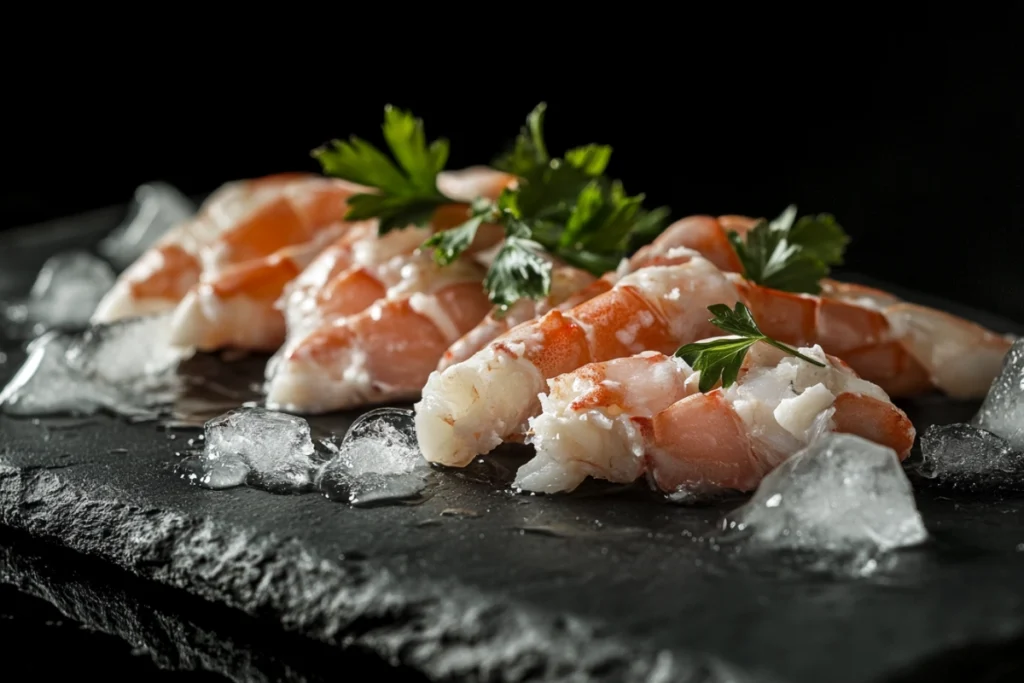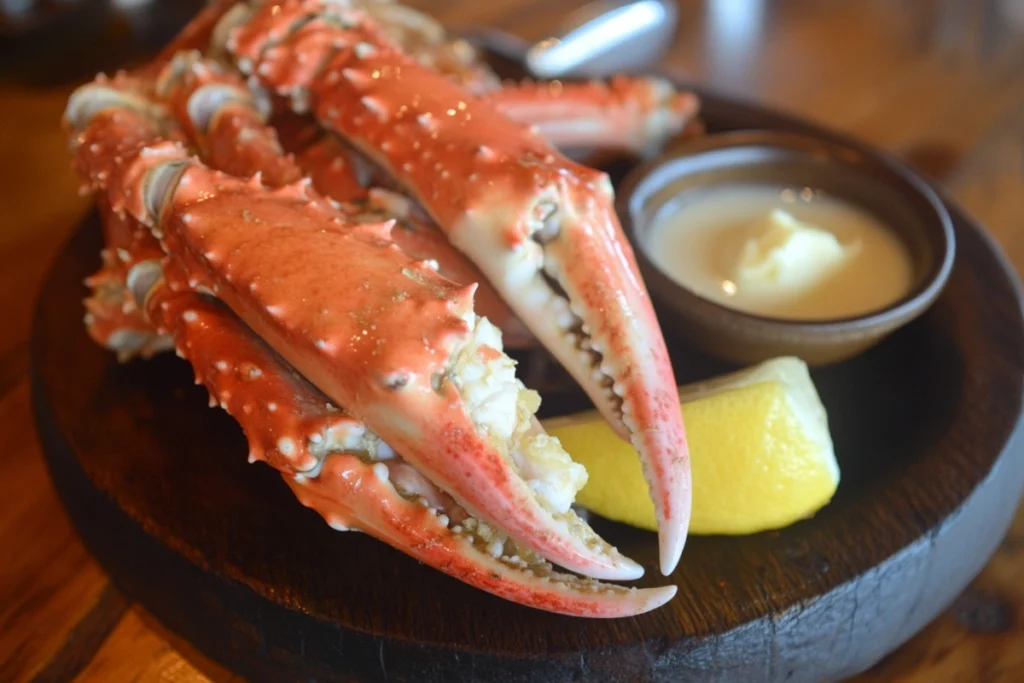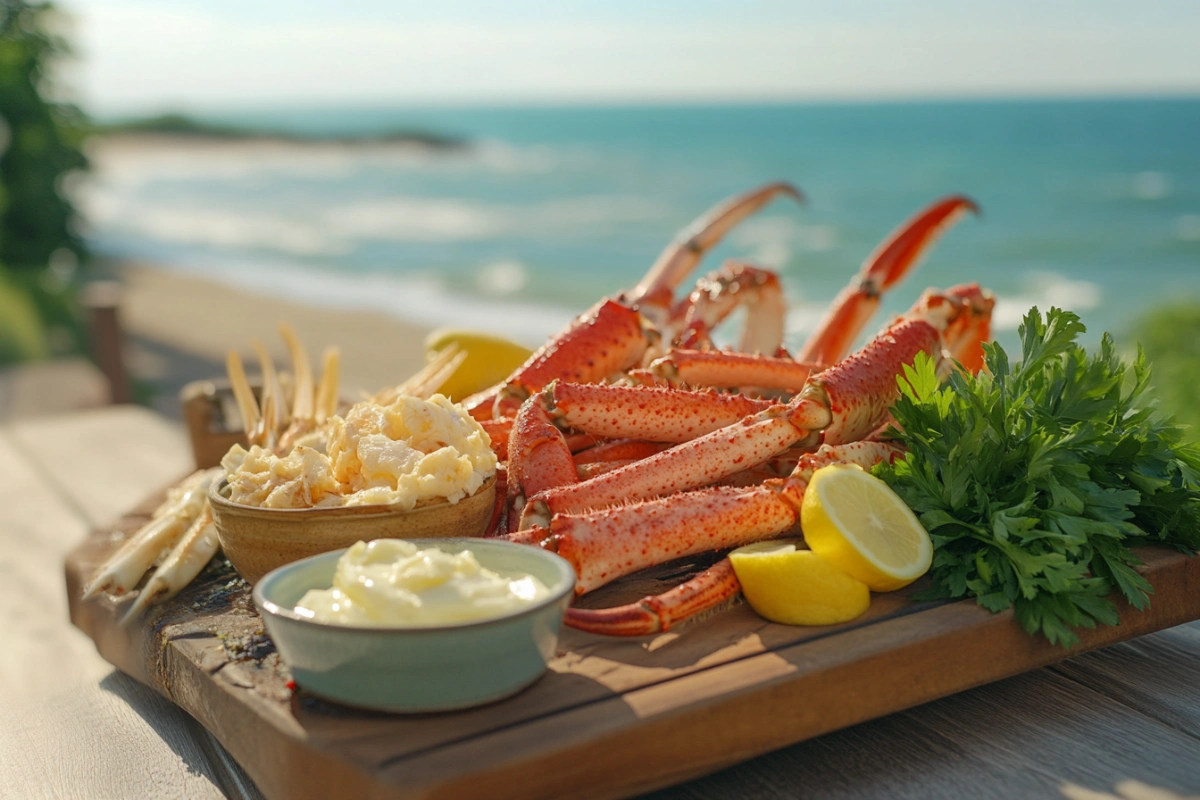Seafood lovers often find themselves pondering the age-old question: What’s better, king crab or snow crab? These two popular crustaceans are prized for their delicate, flavorful meat, but they each offer unique characteristics that set them apart. Whether you’re a gourmet chef, a seafood enthusiast, or just craving a luxurious dining experience, understanding the differences can help you make the right choice.
This article dives deep into a full comparison of king crab vs snow crab across key aspects like taste, texture, price, nutritional value, and cooking methods. By the end, you’ll have a clear picture of which crab fits your taste buds, budget, and special occasions better. Plus, we’ll answer some of the most frequently asked questions about these delicacies and help you decide which one to crack open next.
Introduction to Snow Crab and King Crab
When it comes to choosing between snow crab and king crab, understanding the basics is essential. Both species are highly sought after for their tender, juicy meat, but they differ significantly in size, texture, and culinary uses.
What is a Snow Crab?
Snow crabs are named after their white meat, which turns bright red when cooked. Often called queen crab due to their long, slender legs, they are typically sold in clusters, making them a staple in seafood markets. These crabs are widely available and harvested from the cold waters of the North Atlantic and North Pacific oceans.
Their fibrous meat has a subtly sweet yet savory taste, making it ideal for dishes where the crab’s texture can shine, such as dips, pasta sauces, and salads. Because of their widespread availability and milder flavor, snow crab legs are a more budget-friendly option for everyday meals.
What is a King Crab?
On the other hand, king crabs live up to their regal name. These colossal crustaceans can weigh up to 8 pounds with legs spanning up to 5 feet. King crabs are often synonymous with luxury dining due to their massive size and premium price. They are harvested primarily from the icy waters of Alaska and the Bering Sea during a short harvesting season from late October to January.
Unlike snow crab, king crab meat is chunkier and more tender, often compared to lobster for its sweet, succulent flavor. It’s usually served as a stand-alone delicacy, best enjoyed with melted butter and lemon to emphasize its rich taste.
Key Differences to Note:
- Snow crab legs are thinner, while king crab legs are larger and meatier.
- King crab meat is more tender and sweeter, while snow crab meat is more fibrous with a briny taste.
- Snow crab is often cheaper and easier to find, while king crab is a premium delicacy.
Now that we’ve introduced these two seafood stars, let’s dive deeper into their origins and habitats in the next section.
Origin and Habitat

Understanding where king crab and snow crab originate can help explain their differences in availability, price, and taste. Despite both being cold-water crabs, their habitats are quite distinct.
Snow Crab’s Natural Habitat
Snow crabs thrive in the icy waters of the North Atlantic and North Pacific oceans. These crustaceans prefer shallow, cold waters near the continental shelf, making them more accessible for commercial fishing. Snow crab populations are especially abundant off the coasts of Alaska, Canada, and Norway. Their longer harvesting season, from late fall to early summer, results in a more consistent supply and lower prices compared to king crab.
Snow crabs are often trapped in clusters due to their tendency to stay in groups. This behavior makes them easier to catch in larger quantities, further contributing to their affordability and availability.
King Crab’s Natural Habitat
On the other hand, king crabs reign over the Bering Sea and the Gulf of Alaska. They prefer deeper, colder waters and are often found at depths exceeding 300 feet. Harvesting king crabs is more challenging due to their remote locations and the extreme weather conditions in their natural habitat.
The king crab’s short fishing season, typically lasting from late October to January, adds to its exclusivity and premium pricing. Additionally, their solitary nature requires more effort to capture, contributing to the higher market cost.
The unique environments of both species play a significant role in their taste, texture, and pricing, as we will explore in the next section.
Taste and Texture Differences
When choosing what’s better, king crab or snow crab, the answer often boils down to taste preferences and texture. While both crabs offer delicious, sweet meat, the differences are quite noticeable once you dig in.

Snow Crab Flavor Profile
Snow crab meat is often described as subtly sweet with a briny undertone, making it perfect for lighter dishes where seasoning can shine. The meat is fibrous and easily shredded, making it ideal for recipes like crab dips, soups, and salads where the crab can be mixed with other ingredients.
The texture of snow crab is more delicate, which works well in recipes where smaller, flaky meat pieces blend seamlessly into the dish. Its mild flavor also pairs beautifully with lemon, garlic butter, and creamy sauces.
King Crab Flavor Profile
By contrast, king crab meat is often compared to lobster due to its tender, succulent texture and rich sweetness. The large, thick meat chunks have a buttery, melt-in-your-mouth feel, making them ideal for serving as a stand-alone dish with minimal seasoning.
King crab legs are known for their juiciness and can be cracked open for large pieces of white meat with slight red streaks. This makes them perfect for indulgent meals where the crab is the centerpiece, often served with clarified butter or simple lemon wedges.
Key Differences in Taste and Texture:
- Snow crab: Mild, briny, fibrous, ideal for mixed dishes.
- King crab: Sweet, rich, tender, best served alone.
If you’re wondering what’s better, king crab or snow crab for a fancy dinner, king crab’s luxurious texture is hard to beat. However, snow crab is a fantastic choice for versatile cooking and everyday meals.
Nutritional Value and Health Benefits: king crab vs snow crab
When considering what’s better, king crab or snow crab for your health, understanding their nutritional differences is key. Both crabs are low in fat and high in protein, making them excellent choices for a balanced diet. However, some differences in their nutritional profiles can influence your decision.
Nutritional Content king crab vs snow crab (per 100g)
The nutritional values per 100 grams of cooked meat for both snow crab and king crab are outlined below:
| Nutrient | Snow Crab | King Crab |
|---|---|---|
| Calories | 90 kcal | 130 kcal |
| Protein | 18g | 19g |
| Total Fat | 1g | 2.5g |
| Omega-3 Fatty Acids | 0.4g | 0.5g |
| Vitamin B12 | 4 µg | 3.5 µg |
| Sodium | 600mg | 850mg |
| Iron | 0.6mg | 0.9mg |
Nutritional Content of Snow Crab
Snow crab is a lean seafood choice, perfect for those watching their calorie intake. A 3-ounce serving provides approximately:
- 90 calories
- 18 grams of protein
- 1 gram of fat
Rich in omega-3 fatty acids, snow crab supports heart health and reduces inflammation. It’s also a great source of essential vitamins and minerals like vitamin B12, zinc, and selenium, which contribute to immune support and healthy nerve function.
Since snow crab meat is slightly more fibrous, it’s often served in smaller portions, making it ideal for low-calorie dishes like salads or seafood soups.
Nutritional Content of King Crab
King crab, while also nutrient-dense, is slightly richer due to its higher fat content. A 3-ounce serving typically includes:
- 130 calories
- 19 grams of protein
- 2.5 grams of fat
Though slightly higher in fat, king crab offers a luxurious texture and remains heart-healthy due to its omega-3 content. It also provides impressive levels of copper, magnesium, and phosphorus, essential for bone health and energy production.
If you’re deciding what’s better, king crab or snow crab based on nutrition, both crabs offer exceptional health benefits, but snow crab edges out as the leaner option.
Price and Availability
A crucial factor in deciding what’s better, king crab or snow crab is the price and availability. While both crabs offer unique flavors and textures, their cost can vary greatly due to harvesting challenges and seasonal availability.
Why Is King Crab More Expensive?
King crab is often considered a luxury seafood item, with prices ranging from $50 to $100 per pound. Why so costly? Several factors drive up the price:
- Short harvesting season (late October to January).
- Remote habitats, making them harder to catch.
- Labor-intensive harvesting, requiring specialized gear and crews.
The limited supply and high demand for its succulent meat often make king crab a premium choice for special occasions rather than everyday meals.
Cost Comparison: Snow Crab vs King Crab
In contrast, snow crab is significantly more affordable, typically ranging from $20 to $40 per pound. Its lower cost is due to:
- Longer harvesting season (late fall to early summer).
- Easier accessibility in shallower waters.
- Abundant supply, as they are often caught in clusters.
If you’re searching for an affordable yet delicious seafood option for regular meals, snow crab provides excellent value without compromising taste.
Verdict: If you seek a gourmet experience with tender, sweet meat, king crab is worth the splurge. However, for versatile, everyday dishes like crab pasta or soups, snow crab is the better pick.
For more seafood recipe ideas, check out the Snow Crab Legs Guide.
Cooking and Serving Methods
When it comes to cooking seafood, both king crab and snow crab can be prepared using similar techniques. However, subtle differences in size and texture can influence the best cooking methods for each.
How to Cook Snow Crab Legs
Snow crab legs are known for their delicate texture, which makes them quick and easy to cook. Since their shells are thinner, they require minimal effort to crack open, making them perfect for weeknight dinners or casual seafood feasts.
Here are the most common ways to prepare snow crab legs:
- Boiling: Add the crab legs to a pot of boiling water and cook for about 5-7 minutes.
- Steaming: Place the legs in a steamer basket over boiling water, cover, and steam for 5-6 minutes.
- Broiling: Preheat the oven to broil, brush the legs with butter, and broil for 3-4 minutes per side.
Snow crab pairs well with garlic butter, lemon wedges, or even a tangy seafood cocktail sauce.
How to Cook King Crab Legs
Due to their massive size and thicker shells, king crab legs require a slightly longer cooking process. However, their luxurious, sweet meat makes the effort worthwhile.
Popular cooking methods for king crab include:
- Boiling: Boil the legs for 8-10 minutes.
- Steaming: Steam in a large pot for 7-8 minutes.
- Grilling: Grill the legs over medium heat for 5 minutes per side after brushing with butter.
King crab’s rich flavor shines best when served with minimal seasoning—just melted butter and lemon for a decadent experience.
If you’re wondering what’s better, king crab or snow crab for easy home cooking, snow crab wins for convenience. However, king crab steals the spotlight for a special occasion.
Culinary Uses and Pairings
Deciding what’s better, king crab or snow crab for your next meal depends on how you plan to serve the crab. Each variety brings unique qualities that can elevate different dishes.
Best Dishes Using Snow Crab
Snow crab is incredibly versatile, making it ideal for dishes where the meat can be shredded and blended with other ingredients. Some popular uses include:
- Crab Cakes: The fibrous texture makes it easy to mix with breadcrumbs and seasonings.
- Seafood Salads: Perfect for light summer dishes with avocado and citrus dressings.
- Crab Dips: The slightly briny taste pairs well with creamy dips and crackers.
- Pasta Sauces: Works beautifully in a garlic butter cream sauce for fettuccine.
Since snow crab has a milder flavor, it pairs well with delicate sides like steamed vegetables, herbed rice, and white wine.
Best Dishes Using King Crab
King crab, with its tender, chunky meat, is often the star of the plate rather than a supporting ingredient. Its rich, sweet taste is best highlighted in dishes like:
- King Crab Legs with Butter: The classic presentation—just crab legs, butter, and lemon.
- Seafood Platters: Serve alongside shrimp, oysters, and lobster for a deluxe spread.
- King Crab Bisque: A luxurious seafood soup using king crab chunks and a creamy broth.
King crab pairs beautifully with richer sides like garlic mashed potatoes, grilled asparagus, and a Chardonnay.
In the debate of what’s better, king crab vs snow crab for versatility, snow crab wins for its adaptability, while king crab excels in gourmet, stand-alone dishes.
Sustainability and Harvesting
When comparing what’s better, king crab or snow crab, sustainability plays a significant role. Responsible fishing practices help protect ocean ecosystems and ensure future generations can enjoy these delicious seafood options.
Snow Crab Harvesting Practices
Snow crab fishing is generally more sustainable due to its larger populations and wider distribution. Harvesting occurs in the North Atlantic and North Pacific oceans, where regulations ensure minimal bycatch and healthy population levels. Snow crabs are often caught using crab pots, which reduce damage to the ocean floor compared to other fishing methods.
The longer snow crab season and abundant populations make it easier for fisheries to maintain ethical harvesting standards while keeping the supply steady and prices lower.
King Crab Harvesting Practices
King crab harvesting is more complex due to its limited habitat and shorter fishing season. Primarily harvested from the Bering Sea and Gulf of Alaska, king crab fishing requires stricter quotas to prevent overfishing. The extreme conditions and specialized gear needed also increase the environmental impact.
However, sustainable practices, including quotas and limited permits, have helped protect king crab populations in recent years.
Verdict: If sustainability is your top priority when deciding what’s better, king crab or snow crab, snow crab may be the better choice due to its longer season and larger population.
Which Crab Should You Choose?
So, what’s better, king crab vs snow crab? The answer largely depends on your preferences, budget, and the dining experience you’re after.
Factors to Consider for Taste and Budget
If you crave a luxurious seafood experience with rich, tender meat, king crab is the clear winner. However, its higher price and limited availability may make it a special-occasion choice. On the other hand, snow crab offers a more budget-friendly option with its mild, slightly briny flavor, making it ideal for everyday meals.
For those planning a seafood feast where the crab is the star, king crab legs with melted butter are unforgettable. However, if you’re preparing crab-based dishes like pasta or salads, snow crab blends better due to its fibrous texture.
Ideal Occasions for Snow Crab vs King Crab
- Special Events: King crab fits luxurious dinners, holiday feasts, and celebrations.
- Casual Meals: Snow crab works well for family dinners, soups, and dips.
- Budget-Friendly: Snow crab is the more affordable option for larger gatherings.
Ultimately, what’s better, king crab or snow crab comes down to your culinary goals. If you want decadence and bold flavors, king crab reigns supreme. For affordability and versatility, snow crab takes the crown.

